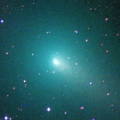
|
Now it is bright as 9.6 mag (Nov. 15, Carlos Labordena). In the Northern Hemisphere, it stays observable in excellent condition for a long time. In the Southern Hemisphere, it will never be observable again after this. It started fading before the peirhelion passage.
Date(TT) R.A. (2000) Decl. Delta r Elong. m1 Best Time(A, h)
Nov. 18 4 34.66 81 29.4 0.851 1.573 117 9.3 0:51 (180,-26)
Nov. 25 3 52.95 84 35.3 0.904 1.605 116 9.6 23:33 (180,-30)
|
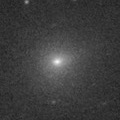
|
Now it is 11.4 mag (Nov. 3, Thomas Lehmann). It is fainter than this ephemeris recently. It stays 11 mag until December. It is observable in good condition in the Northern Hemisphere. It locates very low for a long time in the Southern Hemisphere.
Date(TT) R.A. (2000) Decl. Delta r Elong. m1 Best Time(A, h)
Nov. 18 12 16.77 7 13.6 1.460 1.206 55 10.5 3:05 (259, 3)
Nov. 25 12 42.64 5 2.9 1.460 1.211 55 10.6 2:59 (261, 4)
|
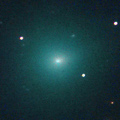
|
Now it is very bright as 10.8 mag (Nov. 2, Maik Meyer). It stays 11 mag until winter. It is observable in good condition in the Northern Hemisphere. It locates low in the Southern Hemisphere.
Date(TT) R.A. (2000) Decl. Delta r Elong. m1 Best Time(A, h)
Nov. 18 11 10.68 11 0.8 1.336 1.384 71 11.2 3:05 (246, 14)
Nov. 25 11 33.02 9 38.8 1.310 1.387 72 11.2 2:59 (247, 15)
|
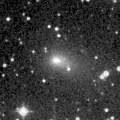
|
Now it is 12.8 mag (Nov. 14, Marco Goiato). It will stay bright as 11 mag for a long time from winter to next spring. In the Southern Hemisphere, it stays observable in good condition until next February. In the Northern Hemispehre, it stays observable for a long time after this until the comet fades out.
Date(TT) R.A. (2000) Decl. Delta r Elong. m1 Best Time(A, h)
Nov. 18 5 18.07 3 2.7 2.273 3.166 149 11.8 1:31 (180, 52)
Nov. 25 5 10.75 4 23.3 2.195 3.126 156 11.7 0:56 (180, 51)
|
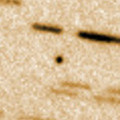
|
It brightened up to 11.6 mag in mid October (Oct. 13, Chris Wyatt). It passed the perihelion on Oct. 27. It will not be observable after this.
Date(TT) R.A. (2000) Decl. Delta r Elong. m1 Best Time(A, h)
Nov. 18 16 14.79 -9 46.9 1.629 0.709 13 12.0 20:25 ( 64,-17)
Nov. 25 16 40.70 -11 34.1 1.805 0.871 12 13.3 20:34 ( 60,-18)
|

|
It brightened up to 7.1 mag from May to June (June 21, Juan Jose Gonzalez). Now it is fading. It has already faded down to 12.4 mag (Nov. 9, Chris Wyatt). In the Southern Hemisphere, it stays observable for a long time after this. It will never be observable again in the Northern Hemisphere.
Date(TT) R.A. (2000) Decl. Delta r Elong. m1 Best Time(A, h)
Nov. 18 18 49.44 -57 3.6 3.092 2.608 52 12.2 20:25 ( 40, 33)
Nov. 25 19 12.04 -57 1.6 3.195 2.672 50 12.4 20:34 ( 40, 32)
|
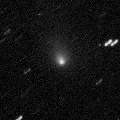
|
It brightened very rapidly from July to August. Now it is very bright as 14.2 mag (Nov. 8, Chris Wyatt). It is observable in excellent condition in the Southern Hemisphere. It stays low for a while in the Northern Hemisphere.
Date(TT) R.A. (2000) Decl. Delta r Elong. m1 Best Time(A, h)
Nov. 18 23 52.03 -30 40.7 2.056 2.531 107 13.7 20:25 (131, 83)
Nov. 25 23 53.20 -29 1.6 2.105 2.504 102 13.6 20:34 (112, 76)
|

|
Now it is visible visually at 13.4 mag (Nov. 14, Sandor Szabo).
Date(TT) R.A. (2000) Decl. Delta r Elong. m1 Best Time(A, h)
Nov. 18 21 11.19 -14 0.1 5.891 5.808 80 13.6 20:25 (105, 44)
Nov. 25 21 14.08 -13 44.7 6.000 5.807 74 13.6 20:34 ( 99, 37)
|
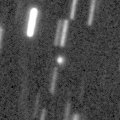
|
Now it is 14.3 mag (Nov. 14, Gabor Santa). It is expected to brighten up to 12 mag from 2018 to 2019. In the Northern Hemisphere, it stays observable in good condition while the comet will be brightening gradually. In the Southern Hemisphere, it is not observable until 2018 October.
Date(TT) R.A. (2000) Decl. Delta r Elong. m1 Best Time(A, h)
Nov. 18 15 16.63 47 16.8 3.916 3.638 66 14.3 3:05 (236,-48)
Nov. 25 15 20.91 47 36.8 3.826 3.592 68 14.2 2:59 (235,-45)
|
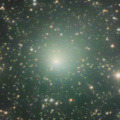
|
It brightened up to 10 mag from spring to summer. Now it is fading. It has already faded down to 13.2 mag (Nov. 7, Thomas Lehmann). It is observable in excellent condition in the Southern Hemisphere. It locates low in the Northern Hemisphere.
Date(TT) R.A. (2000) Decl. Delta r Elong. m1 Best Time(A, h)
Nov. 18 21 5.24 -26 21.6 2.047 2.041 75 14.3 20:25 ( 89, 49)
Nov. 25 21 20.01 -24 55.0 2.153 2.077 72 14.6 20:34 ( 88, 44)
|
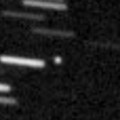
|
Now it is 16.4 mag (Oct. 29, Katsumi Yoshimoto). It will approach to Earth down to 0.07 a.u. in mid December, and it will brighten up to 10 mag. In the Northern Hemisphere, it stays observable in excellent condition until mid December. In the Southern Hemisphere, it stays low.
Date(TT) R.A. (2000) Decl. Delta r Elong. m1 Best Time(A, h)
Nov. 18 7 5.74 36 0.7 0.562 1.420 130 15.2 3:05 (183, 19)
Nov. 25 7 0.66 37 14.5 0.423 1.332 138 14.3 2:46 (180, 18)
|
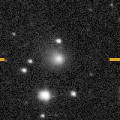
|
Now it is 13.7 mag (Nov. 14, Gabor Santa). It is expected to brighten up to 10 mag in summer in 2018. In the Northern Hemisphere, it stays observable until 2018 summer while the comet will be brightening. However, it will be extremely low from December to January. In the Southern Hemisphere, it is hardly observable in 2017, but it will be observable in good condition in 2018.
Date(TT) R.A. (2000) Decl. Delta r Elong. m1 Best Time(A, h)
Nov. 18 17 36.52 16 14.6 4.255 3.648 46 14.4 20:25 ( 98,-17)
Nov. 25 17 42.50 14 42.9 4.249 3.592 43 14.4 20:34 ( 93,-22)
|
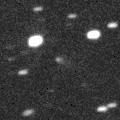
|
Now it is 16.5 mag (Nov. 15, Toshihiko Ikemura, Hirohisa Sato). It will approach to Earth down to 0.2 a.u., and to Sun down to 0.6 a.u., and it is expected to brighten up to 9 mag from winter to spring. In the Northern Hemisphre, it stays observable in good condition until January, but it will be extremely low after that. In the Southern Hemisphere, it is not observable from January to mid March, but it stays observable in good condition except for that period.
Date(TT) R.A. (2000) Decl. Delta r Elong. m1 Best Time(A, h)
Nov. 18 8 52.60 -3 30.6 1.470 1.887 98 15.1 3:05 (228, 48)
Nov. 25 8 55.42 -2 42.4 1.256 1.783 104 14.5 2:59 (222, 50)
|
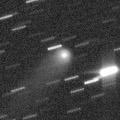
|
Now it is 13.6 mag (Oct. 23, Toshihiko Ikemura, Hirohisa Sato). It will be observable at 14 mag for a long time from 2017 to 2018. In the Southern Hemisphere, it will be hardly observable after this. It will be extremely low from November to December in the Northern Hemisphere.
Date(TT) R.A. (2000) Decl. Delta r Elong. m1 Best Time(A, h)
Nov. 18 16 16.25 19 7.6 4.528 3.820 39 14.6 20:25 ( 90,-35)
Nov. 25 16 18.83 19 24.4 4.506 3.807 40 14.6 20:34 ( 85,-42)
|
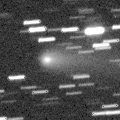
|
It brightened up to 12.2 mag in August (Aug. 21, Juan Jose Gonzalez). It is fading now. It has already faded down to 15.2 mag (Nov. 15, Toshihiko Ikemura, Hirohisa Sato).
Date(TT) R.A. (2000) Decl. Delta r Elong. m1 Best Time(A, h)
Nov. 18 8 21.54 10 10.1 1.354 1.931 110 15.0 3:05 (209, 40)
Nov. 25 8 21.76 10 31.2 1.334 1.988 117 15.1 2:59 (203, 42)
|
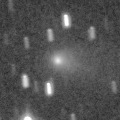
|
Now it is 15.0 mag (Oct. 30, D. Buczynski). It brightened rapidly. It is observable at 15 mag in autumn in good condition in the Northern Hemisphere. It locates low in the Southern Hemisphere.
Date(TT) R.A. (2000) Decl. Delta r Elong. m1 Best Time(A, h)
Nov. 18 5 38.72 37 46.3 1.130 2.032 146 15.0 1:52 (180, 17)
Nov. 25 5 34.20 38 42.1 1.124 2.054 153 15.0 1:20 (180, 16)
|
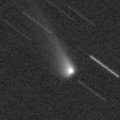
|
Now it is 14.4 mag (Oct. 27, Catalina Sky Survey). It stays observable at 15-16 mag for a long time from 2017 to 2018.
Date(TT) R.A. (2000) Decl. Delta r Elong. m1 Best Time(A, h)
Nov. 18 0 37.07 8 22.5 3.507 4.274 136 15.0 20:46 (180, 47)
Nov. 25 0 30.17 6 35.3 3.606 4.271 126 15.1 20:34 (172, 48)
|
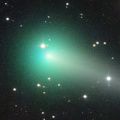
|
It brightened up to 6.2 mag in April (Apr. 7, Juan Jose Gonzalez). Now it is fading rapidly. It has already faded down to 13.5 mag (Nov. 14, Sandor Szabo). It stays observable for a long time after this.
Date(TT) R.A. (2000) Decl. Delta r Elong. m1 Best Time(A, h)
Nov. 18 3 2.92 18 0.8 1.980 2.963 172 15.1 23:12 (180, 37)
Nov. 25 2 56.72 17 22.7 2.081 3.042 164 15.3 22:38 (180, 38)
|
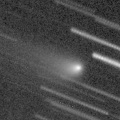
|
Now it is 15.3 mag (Nov. 11, Toshihiko Ikemura, Hirohisa Sato). It will be fading after this.
Date(TT) R.A. (2000) Decl. Delta r Elong. m1 Best Time(A, h)
Nov. 18 19 4.43 -17 6.2 3.381 2.849 50 15.3 20:25 ( 82, 20)
Nov. 25 19 4.58 -17 37.7 3.513 2.871 42 15.4 20:34 ( 77, 12)
|
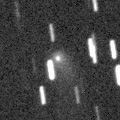
|
Now it is 14.8 mag (Nov. 14, Gabor Santa). In the Northern Hemisphere, it stays 15 mag until winter, and it is observable in excellent condition. It is not observable at all after this in the Southern Hemisphere.
Date(TT) R.A. (2000) Decl. Delta r Elong. m1 Best Time(A, h)
Nov. 18 19 46.99 63 55.4 2.995 3.255 96 15.4 20:25 (154,-22)
Nov. 25 19 46.38 63 7.6 3.038 3.268 94 15.5 20:34 (151,-25)
|
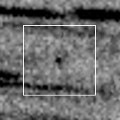
|
It will brighten very rapidly, and brighten up to 11 mag from January to February. In the Northern Hemisphere, it stays observable for a long time in the evening sky. In the Southern Hemisphere, it locates extremely low at the highlight.
Date(TT) R.A. (2000) Decl. Delta r Elong. m1 Best Time(A, h)
Nov. 18 19 1.78 -12 12.4 1.757 1.363 50 16.0 20:25 ( 87, 17)
Nov. 25 19 20.83 -12 14.6 1.729 1.299 48 15.5 20:34 ( 84, 13)
|
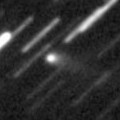
|
Now it is 14.5 mag (Nov. 9, Chris Wyatt). It stays 15 mag until winter. In the Southern Hemisphere, it stays observable in excellent condition until spring in 2018. In the Northern Hemisphere, it stays unobservable until 2018.
Date(TT) R.A. (2000) Decl. Delta r Elong. m1 Best Time(A, h)
Nov. 18 1 27.78 -70 39.3 1.871 2.079 87 15.5 21:37 ( 0, 55)
Nov. 25 1 25.75 -67 21.0 1.853 2.058 87 15.5 21:07 ( 0, 58)
|

|
Now it is 15.6 mag (Oct. 25, Yasukazu Ikari). It stays 17 mag in 2018.
Date(TT) R.A. (2000) Decl. Delta r Elong. m1 Best Time(A, h)
Nov. 18 3 24.42 -0 53.6 5.266 6.204 159 15.5 23:33 (180, 56)
Nov. 25 3 21.89 -1 5.1 5.318 6.233 156 15.6 23:03 (180, 56)
|

|
Now it is 16.7 mag (Nov. 2, A. Diepvens). It will be observable at 15 mag in good condition from winter to spring.
Date(TT) R.A. (2000) Decl. Delta r Elong. m1 Best Time(A, h)
Nov. 18 11 25.66 10 15.3 3.801 3.545 67 15.9 3:05 (249, 11)
Nov. 25 11 32.01 9 46.9 3.703 3.544 73 15.8 2:59 (247, 15)
|
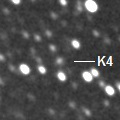
|
Now it is 15.0 mag (Oct. 10, Toshihiko Ikemura, Hirohisa Sato). It stays 16 mag for a long time until summer in 2018. It will be unobservable from winter to spring.
Date(TT) R.A. (2000) Decl. Delta r Elong. m1 Best Time(A, h)
Nov. 18 18 54.74 -23 2.2 3.273 2.697 46 15.9 20:25 ( 76, 21)
Nov. 25 19 7.76 -22 12.9 3.321 2.685 42 15.9 20:34 ( 74, 16)
|
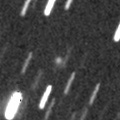
|
Now it is 17.1 mag (Oct. 27, Yuji Ohshima). It stays observable at 16 mag for a long time until summer in 2018. It is observable in good condition in the Northern Hemisphere in 2017, and in the Southern Hemisphere in 2018.
Date(TT) R.A. (2000) Decl. Delta r Elong. m1 Best Time(A, h)
Nov. 18 2 31.02 64 42.7 1.248 2.056 133 16.1 22:33 (180,-10)
Nov. 25 1 8.53 59 54.4 1.212 1.998 130 15.9 20:46 (180, -5)
|

|
Now it is 16.3 mag (Nov. 15, Toshihiko Ikemura, Hirohisa Sato). It stays 16-17 mag for a long time from 2016 to 2019. It stays near by the equator.
Date(TT) R.A. (2000) Decl. Delta r Elong. m1 Best Time(A, h)
Nov. 18 10 29.49 4 0.1 9.720 9.564 78 16.1 3:05 (244, 26)
Nov. 25 10 31.06 3 56.7 9.606 9.566 84 16.0 2:59 (240, 30)
|
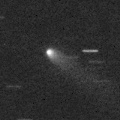
|
Now it is 15.2 mag (Nov. 14, Sandor Szabo). It will be fading after this, and it will be fainter than 18 mag in March.
Date(TT) R.A. (2000) Decl. Delta r Elong. m1 Best Time(A, h)
Nov. 18 0 56.52 17 19.4 2.114 2.963 142 16.1 21:06 (180, 38)
Nov. 25 0 54.79 17 13.3 2.188 2.975 135 16.2 20:37 (180, 38)
|
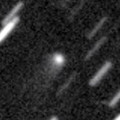
|
Now it is 16.3 mag (Nov. 15, Toshihiko Ikemura, Hirohisa Sato). It stays 16 mag for a long time from 2017 to 2018. It is observable in excellent condition in the Northern Hemisphere. It locates very low in the Southern Hemisphere.
Date(TT) R.A. (2000) Decl. Delta r Elong. m1 Best Time(A, h)
Nov. 18 9 15.68 25 6.3 5.038 5.328 101 16.3 3:05 (215, 21)
Nov. 25 9 13.51 26 15.6 4.916 5.328 109 16.2 2:59 (209, 23)
|
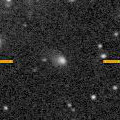
|
Now it is 16.1 mag (Nov. 15, Toshihiko Ikemura, Hirohisa Sato). It is expected to brighten up to 13-14 mag from 2018 to 2019. In the Northern Hemisphere, it stays observable in good condition for a long time. In the Southern Hemisphere, it is not observable until summer in 2018.
Date(TT) R.A. (2000) Decl. Delta r Elong. m1 Best Time(A, h)
Nov. 18 18 34.62 46 50.7 5.182 5.063 77 16.6 20:25 (133,-22)
Nov. 25 18 38.21 45 27.7 5.182 5.018 75 16.6 20:34 (129,-26)
|
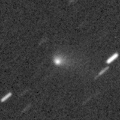
|
Now it is 14.7 mag (Nov. 15, Toshihiko Ikemura, Hirohisa Sato). Return of a new periodic comet which brightened up to 13 mag in 2004. It will be observable in excellent condition in autumn. It was expected to brighten up to 14 mag, if the comet is as bright as when it was discovered. It had been fainter than expected, but it became brighter in November.
Date(TT) R.A. (2000) Decl. Delta r Elong. m1 Best Time(A, h)
Nov. 18 2 19.37 11 56.9 0.785 1.749 160 16.6 22:28 (180, 43)
Nov. 25 2 16.41 13 20.0 0.823 1.763 153 16.8 21:58 (180, 41)
|
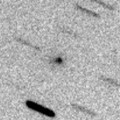
|
Now it is 17.2 mag (Nov. 2, A. Diepvens). It stays observable at 17 mag in good condition for a while. It will be fainter than 18 mag in May.
Date(TT) R.A. (2000) Decl. Delta r Elong. m1 Best Time(A, h)
Nov. 18 12 53.90 -0 18.1 2.642 2.039 43 16.6 3:05 (270, 0)
Nov. 25 13 8.06 -1 27.5 2.611 2.063 46 16.7 2:59 (270, 2)
|
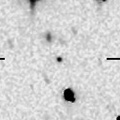
|
Now it is 16.6 mag (Oct. 24, Catalina Sky Survey). It will be observable at 16.5 mag in good condition in winter.
Date(TT) R.A. (2000) Decl. Delta r Elong. m1 Best Time(A, h)
Nov. 18 9 42.85 -1 20.1 2.618 2.754 87 16.7 3:05 (239, 38)
Nov. 25 9 48.12 -3 4.2 2.555 2.775 92 16.7 2:59 (237, 42)
|
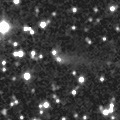
|
Now it is 16.9 mag (Nov. 2, A. Diepvensy). In the Northern Hemisphere, it will be observable at 17 mag in excellent condition from autumn to winter. It locates low in the Southern Hemisphere.
Date(TT) R.A. (2000) Decl. Delta r Elong. m1 Best Time(A, h)
Nov. 18 5 39.27 35 21.6 2.280 3.161 147 16.7 1:52 (180, 20)
Nov. 25 5 35.15 35 40.2 2.257 3.178 154 16.7 1:21 (180, 19)
|
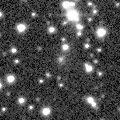
|
Now it is 16.7 mag (Nov. 15, Toshihiko Ikemura, Hirohisa Sato). It will pass the perihelion in 2019. However, it has not been brightening since the discovery in 2010. It is observable in good conditioin in the Northern Hemisphere. It is not observable for a long time in the Southern Hemisphere.
Date(TT) R.A. (2000) Decl. Delta r Elong. m1 Best Time(A, h)
Nov. 18 7 1.51 73 59.1 8.367 8.880 118 16.9 3:05 (181,-19)
Nov. 25 6 58.05 74 36.8 8.314 8.867 121 16.8 2:45 (180,-20)
|

|
Now it is 16.1 mag (Oct. 29, N. James). It stays 16 mag from 2016 to 2017. In the Northern Hemisphere, it stays observable in good condition for a long time. In the Southern Hemisphere, it will never be observable again.
Date(TT) R.A. (2000) Decl. Delta r Elong. m1 Best Time(A, h)
Nov. 18 18 40.37 59 10.5 6.644 6.669 87 16.9 20:25 (145,-27)
Nov. 25 18 49.37 58 56.5 6.669 6.686 86 16.9 20:34 (144,-30)
|

|
Now it is 17.3 mag (Nov. 11, Toshihiko Ikemura, Hirohisa Sato). It will brighten up to 9 mag in 2018 summer. However, it is hardly observable when it is bright. In the Northern Hemisphere, it is observable only until March when it brightens up to 14 mag. In the Southern Hemisphere, it is observable from July to September in 2018, but it locates in extremely low.
Date(TT) R.A. (2000) Decl. Delta r Elong. m1 Best Time(A, h)
Nov. 18 21 36.82 71 43.1 3.202 3.637 108 17.1 20:25 (168,-20)
Nov. 25 21 44.49 69 27.5 3.131 3.559 107 17.0 20:34 (164,-20)
|
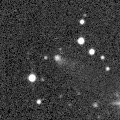
|
Now it is 18.1 mag (Oct. 25, D. Buczynski). It is observable in good condition in the Northern Hemisphere. It locates very low in the Southern Hemisphere.
Date(TT) R.A. (2000) Decl. Delta r Elong. m1 Best Time(A, h)
Nov. 18 7 28.57 35 29.4 2.452 3.137 126 17.1 3:05 (188, 19)
Nov. 25 7 27.00 35 53.8 2.404 3.161 133 17.1 2:59 (183, 19)
|
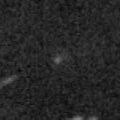
|
Now it is 18.5 mag (Oct. 21, Jonathan L. Tuten, D. Breedlove, B. Lutkenhoner). Appearing in the morning sky. It will be fading slowly after this.
Date(TT) R.A. (2000) Decl. Delta r Elong. m1 Best Time(A, h)
Nov. 18 11 34.26 -8 36.6 3.001 2.626 58 17.1 3:05 (266, 21)
Nov. 25 11 40.86 -9 33.1 2.968 2.681 63 17.1 2:59 (264, 25)
|

|
Now it is 16.6 mag (Sept. 16, P. Camilleri, H. Williams). It will brighten up to 14 mag from autumn to winter in 2018, and it will be observable in excellent condition in the Northern Hemisphere. In 2017, it is observable at 17 mag in excellent condition in the Southern Hemisphere.
Date(TT) R.A. (2000) Decl. Delta r Elong. m1 Best Time(A, h)
Nov. 18 22 56.37 -38 16.6 3.417 3.614 93 17.1 20:25 ( 73, 74)
Nov. 25 22 56.33 -36 43.9 3.467 3.570 87 17.1 20:34 ( 78, 67)
|
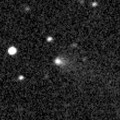
|
First return of a new periodic comet discovered in 2000. Now it is 17.4 mag (Nov. 11, Toshihiko Ikemura, Hirohisa Sato). Although it has been brightening even after the perihelion passage, it will be fading after this.
Date(TT) R.A. (2000) Decl. Delta r Elong. m1 Best Time(A, h)
Nov. 18 0 24.90 -1 26.8 2.093 2.826 129 17.4 20:34 (180, 56)
Nov. 25 0 24.75 -0 26.0 2.194 2.852 122 17.6 20:34 (168, 55)
|
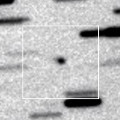
|
Now it is 16.6 mag (Oct. 26, Yuji Ohshima). It stays observable at 18 mag for a long time until 2019.
Date(TT) R.A. (2000) Decl. Delta r Elong. m1 Best Time(A, h)
Nov. 18 6 48.25 19 26.0 7.271 7.990 134 17.8 3:01 (180, 36)
Nov. 25 6 43.37 19 14.1 7.182 7.985 142 17.8 2:29 (180, 36)
|

|
Possible first interstellar object in the history. It approached to Sun down to 0.25 a.u. on Sept. 9. Now it is fading rapidly. It was 19.0 mag in mid October (Oct. 14, Catalina Sky Survey). But it has already fade down to 23.9 mag (Nov. 12, W. H. Ryan, E. V. Ryan).
Date(TT) R.A. (2000) Decl. Delta r Elong. m1 Best Time(A, h)
Nov. 18 23 17.80 6 22.5 1.252 1.913 116 24.9 20:25 (159, 46)
Nov. 25 23 16.85 6 44.8 1.513 2.068 109 25.5 20:34 (147, 42)
|
|
![]()
 188P/LINEAR-Mueller
188P/LINEAR-Mueller 103P/Hartley 2
103P/Hartley 2 (944) Hidalgo
(944) Hidalgo 352P/2017 L1 ( Skiff )
352P/2017 L1 ( Skiff ) C/2015 XY1 ( Lemmon )
C/2015 XY1 ( Lemmon ) 1I/2017 U1 ( 'Oumuamua )
1I/2017 U1 ( 'Oumuamua )![]()







































